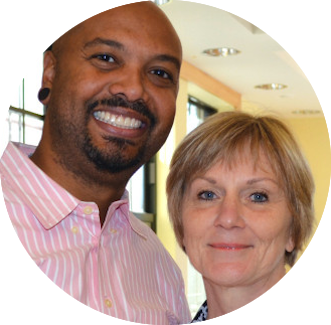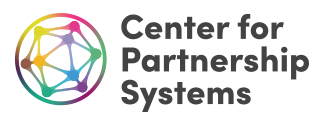 November 5, 2019
November 5, 2019
by By Martha Caldwell and Oman Frame, CPS Partnership Community
Editor?s note: When we received Martha?s submission for the Leader?s Blog, she shared: ?Oman and I have facilitated hundreds of such conversations and have used the partnership model from the start. We also cited Riane in our book.? Thank you Martha and Oman for your groundbreaking work creating partnership, identity-safe spaces ?that generate transformational change?.
For ten years, we?ve worked with organizations to create cultures of compassion, places of belonging where people feel valued and inspired to be their authentic selves. We engage groups in dynamic conversations about their diverse identity experience, and these conversations have the potential, if facilitated effectively, to create identity-safe spaces that generate transformational change.
Organizations that understand how to leverage differences enjoy the benefits of more stable, thriving cultures. Yet all too often, conversations about the impact of race, gender, class and other social identities go awry. An empathy-based communication model can unify rather than divide people and yield transformation rather than confrontation.
We know diverse and inclusive environments make us smarter and better. Everyone wants to harness the power of difference to create dynamic synergy, but the question is how. How can we make a collective shift from dominator to partnership mentality in our organizations? What mindset do we need to cultivate? Before we can begin to have conversations that bring people together, we need to create an identity-safe environment.
Mindset and setting
First, we set up the physical space to reflect the inclusive mindset we?re trying to create. If possible, we put the chairs in a circle, so people can see each other.
We think about the mental field we?re trying to create. Everyone has their own way of doing this, but the idea is that you prepare yourself to hold space for others to, as Ticht Nhat Han says, empty their hearts. We take a few minutes to get in the zone. This work is frequently a calling, so whatever forces your work with, just take a few minutes to connect with your purpose for doing this work.
To hold space for others, you need to be entirely, 100% present, and in a place of non-judgement. You move to a place of witness, not a place of control. It?s a heart space in which you give up control. Your role is to follow someone?s story wherever it takes you, and to effectively do this, you need to be receptive.
Every group we?ve ever worked with calls for acceptance, respect, empathy, honesty, courage, confidentiality and trust. This framework allows people to embrace differences and begin to see each other?s differences as strengths.
Create connectedness
When you start the session, you may need to give folks the opportunity to downshift from their busy lives. You want get them in the zone too. We spend a good bit of time up front creating the space, and it pays off. Because once people feel connected, they feel safe enough to express their truth.
We try to help people connect to each other. Icebreaker activities like pair and share not only get people up and moving, which raises the energy in the room, but they also get people engaged with each other. I love using the question ?What did it take for you to get here today?? because it acknowledges the effort people put in to just show up.
A mindfulness moment
You may want to include a mindful moment, a minute of silence, a meditative body scan, a silent reflection on what each person would like to contribute to the session. Allowing participants give voice to a word that expresses what they?d like to contribute or what they?d like to receive from the session can be a powerful activity.
What do you need to feel safe?
We always begin with the question, ?What do you need from the people in this room to feel safe enough to share your authentic experience?? Then we write down the answers people in the group call out in a visible place. The answers to this question will provide the guidelines that set the tone for the ensuing conversations.
What groups say they need
The answers this question elicits rarely vary. We?ve worked with children as young as ten-years-old and adults in professional communities, and no matter their age, race, gender, religion or political beliefs, they always say the same thing. Every group we?ve ever worked with calls for acceptance, respect, empathy, honesty, courage, confidentiality and trust. These higher order qualities are what make it safe to share deeper truths. These qualities unite us and create inclusive safe places. They transcend individual experiences and diverse identities to create a framework in which differences can be accepted and affirmed. This framework allows people to embrace differences and begin to see each other?s differences as strengths.
We ask the group if they can commit to providing the qualities they generated during this activity to each other during the session. The answer is always yes.
Establish clear communication norms
We add the following norms because we have found that they work to enhance identity-safety.
- Speak your truth.
- Listen 10x more than you speak.
- Allow yourself to feel uncomfortable.
- Expect and accept non-closure
- If you feel conflict, go to the source.
Conclusion
Human beings of all ages are motivated by the need to belong. This need, if met in healthy ways, strengthens relationships, builds bridges across differences, and sets the stage for higher order thinking and creative problem solving. If unmet, the need to belong leaves us vulnerable to negative forms of relating based on power and prestige which undermine authentic, dynamic connections.
Though a precise and reliable process, we can design communities that meet the need to belong. By establishing communities that make authentic dialogue possible, individuation and inclusion flourish. When the need to belong is met, communities can move into authentic inquiry, creating vision and strategy for productive change.
Martha Caldwell and Oman Frame, authors of Let’s Get Real: Exploring Race, Class, and Gender Identities in the Classroom, are veteran educators and co-founders of iChange Collaborative. They provide professional development training and consulting in diversity, equity and inclusions best practices for organizations.
Contact Martha: martha@ichangecollaborative.com





Leave a Reply